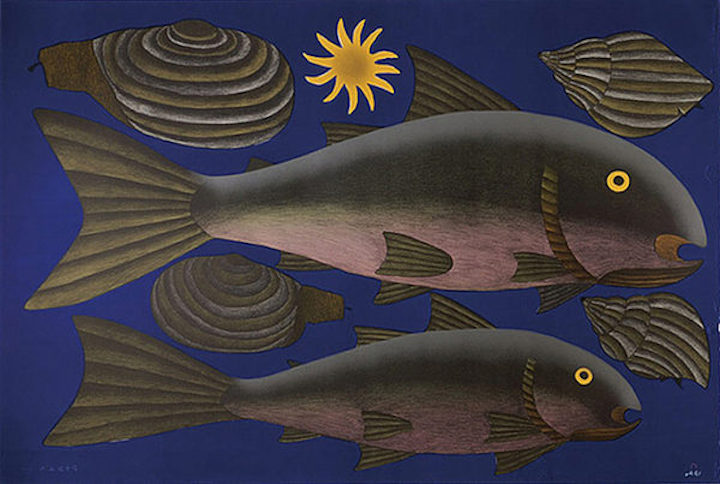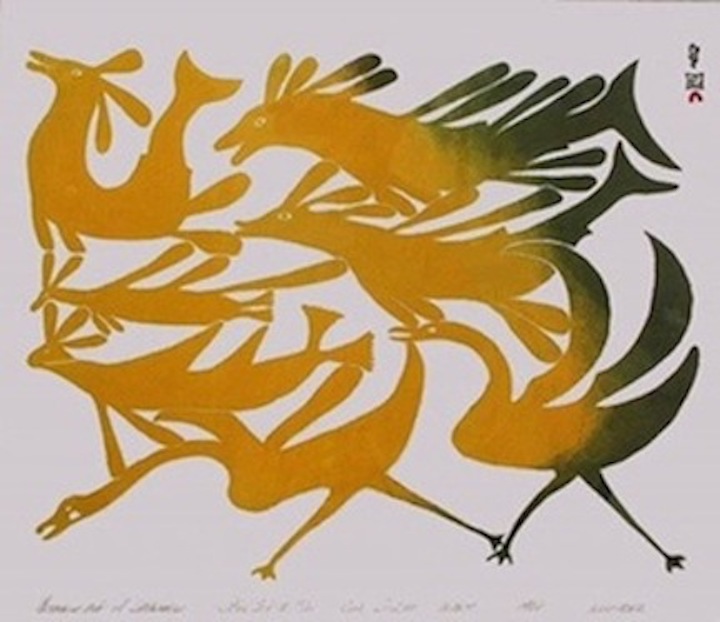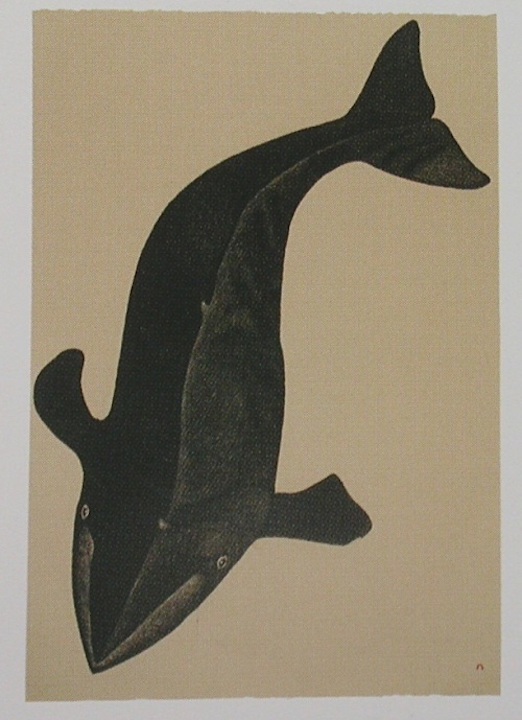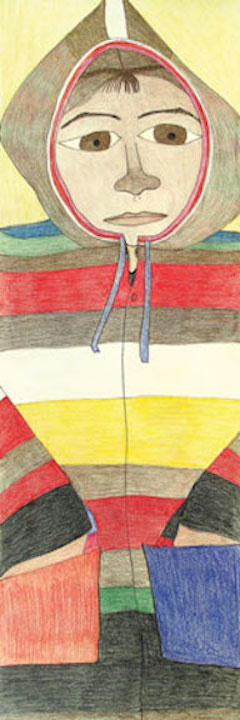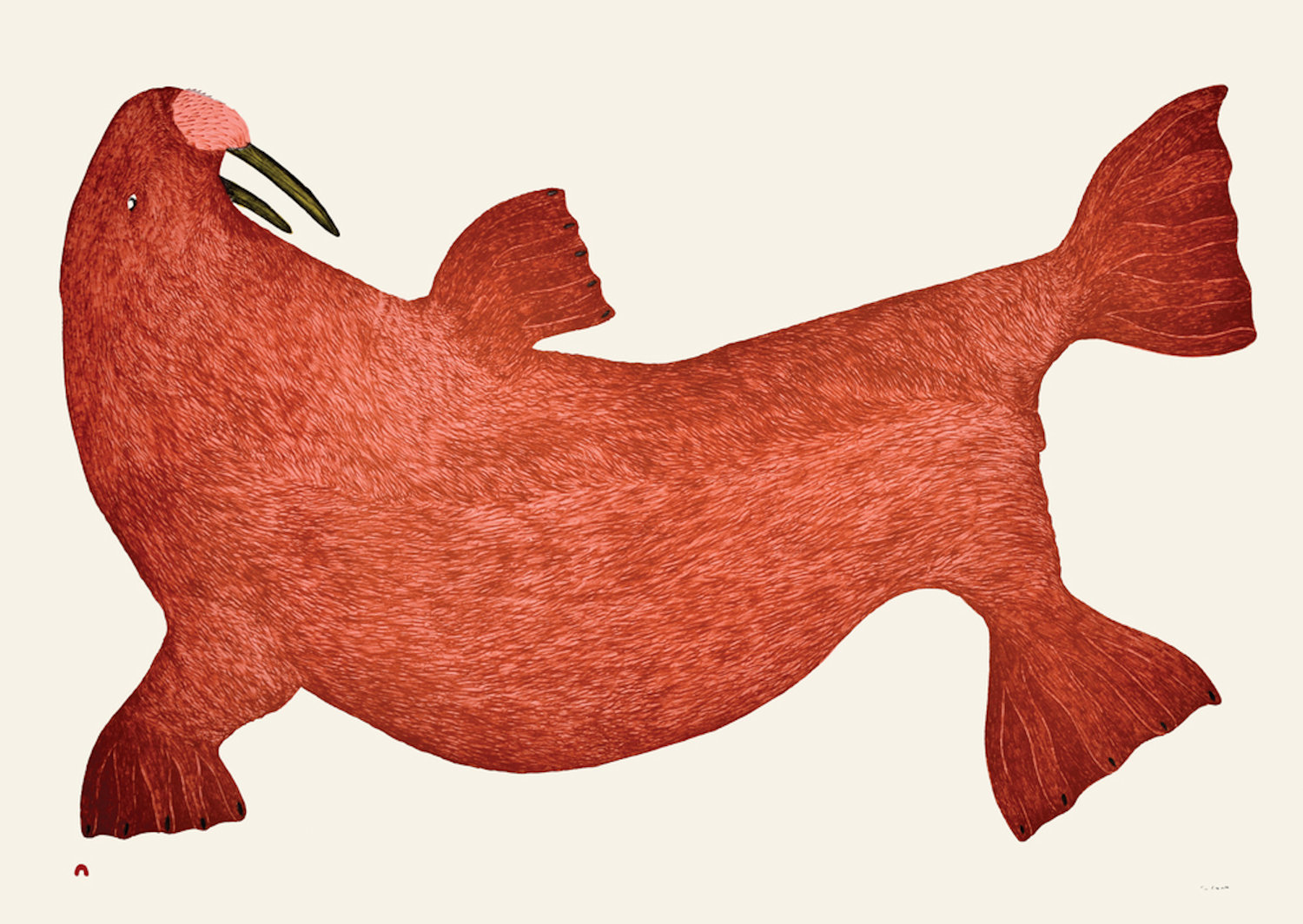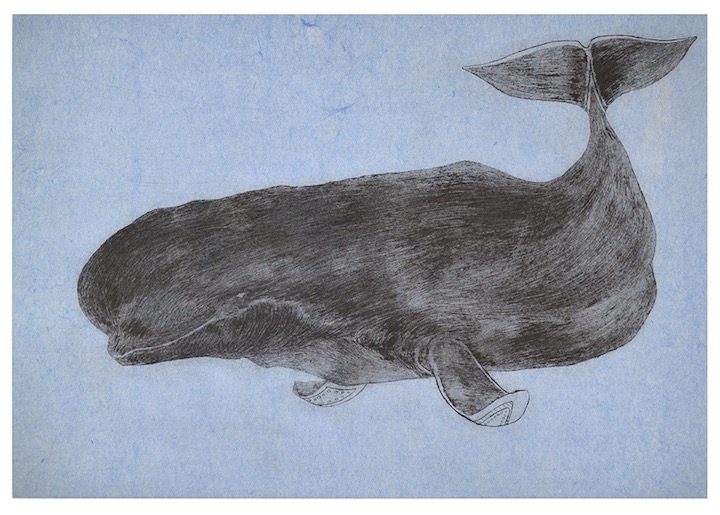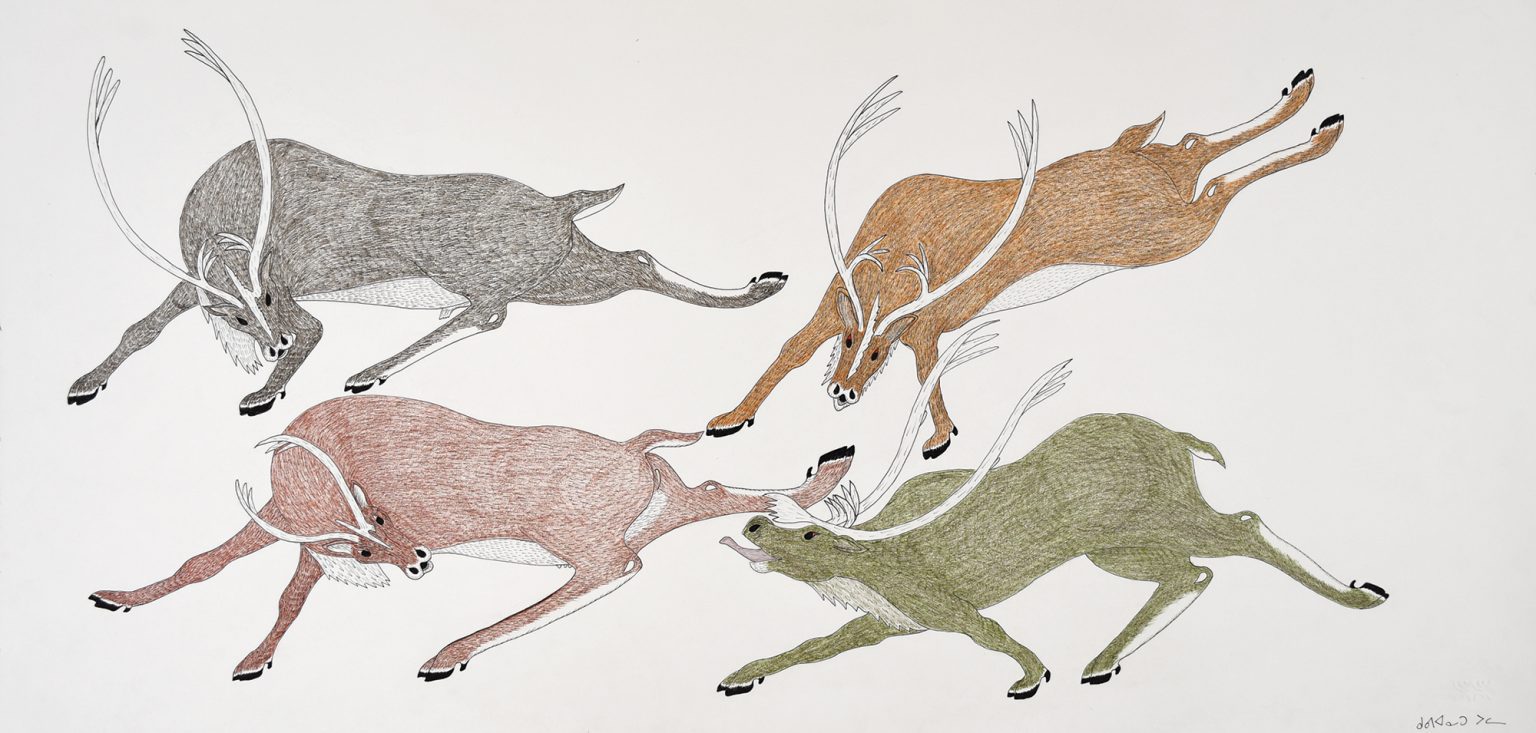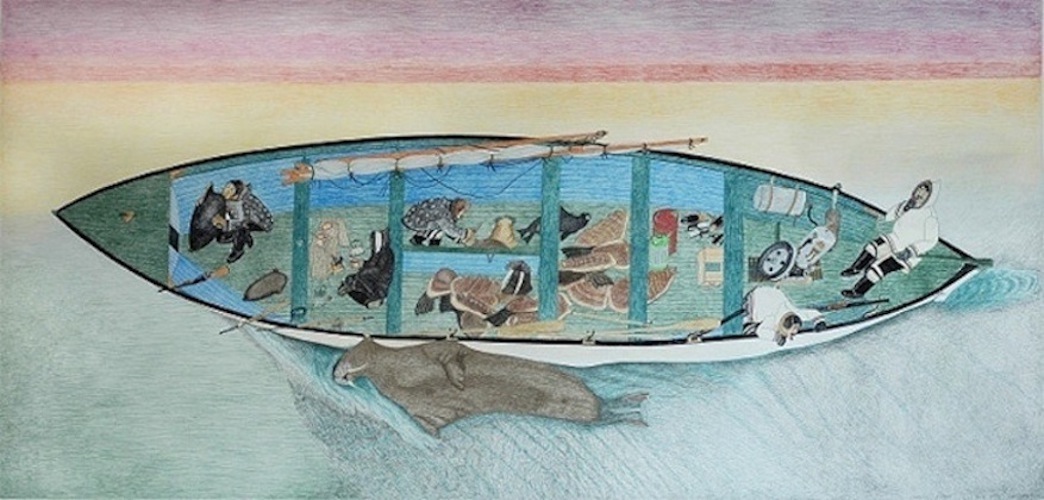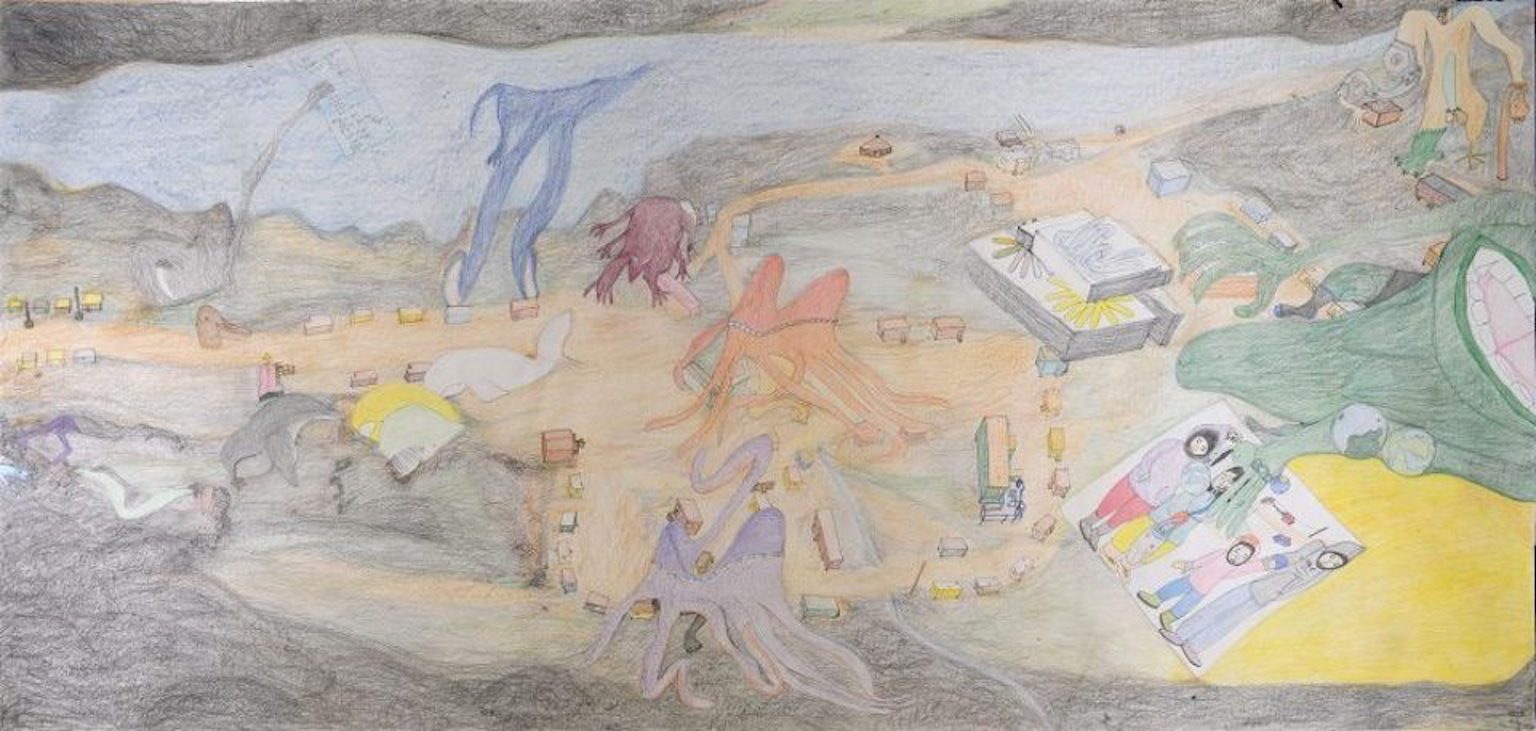Collector's Corner
OVERSIZED: Large Scale Works on Paper by Cape Dorset Artists
When people refer to the early days of Cape Dorset graphic art the time period which they mean is the 1960s. In that era, the prints and drawings the community produced were generally of small dimensions, though there were exceptions. For prints, sizes were generally 8.5” x 11.25,” 12” x 10,” with many being in the 19” x 13” range.
Animals Out Of Darkness, signed Kenojuak Ashevak, but known to be the work of her husband Johnniebo Ashevak (1923-1972), Cape Dorset, stonecut on paper, 5/50 , 19½” x 21¾” (1961). Ex-collection of Honorable Mark M. de Weerdt, Chief Justice, Northwest Territories, Canada. Collection of E. J. Guarino. Photo courtesy of the Marion Scott Gallery, Vancouver and Dorset Fine arts.
A notable exception is Kenojuak Ashevak’s 1961 print Animals Out of Darkness (19.5” x 21.75,” unusual for the era), which didn’t enter my collection until 2010.
Overwhelmingly, prints were based on drawings, but not all drawings were used for this purpose. Those that were not selected were archived. However, a few were released to galleries for sale. Over the years, thanks to farsighted gallerists such as Pat Feheley, owner of Feheley Fine Arts in Toronto, and Judy Scott Kardosh and Robert Kardosh, of the Marion Scott Gallery in Vancouver, the market changed. These gallerists helped build a base of collectors who not only have an avid interest in Inuit drawings, particularly those from Cape Dorset, but in some cases collect them exclusively. In the 1990s a number of Cape Dorset artists such as Kananginak Pootoogook and Napachie Pootoogook created quite a number of stand-alone drawings. The ensuing generation and subsequent generations followed their lead. For the most part, the dimensions of the drawings were 20” x 26”.
As a collector of Inuit graphics for over twenty-five years, particularly those from Cape Dorset, I began to notice some very interesting changes taking place with regard to the size of prints and drawings. While graphics in other Inuit communities began to fade and in some cases completely disappear, those of Cape Dorset thrived as artists embraced new techniques and subjects. A number of artists were also “working large,” experimenting with producing oversized prints and drawings,
I first began to notice the move to embrace larger formats in 2003 when I acquired Deep Blue Sea by Kenojuak Ashevak and Arvialuk (Great Big Whale) by Kananginak Pootoogook. Up until that time I had never seen Inuit prints of such large dimensions.
Deep Blue Sea by Kenojuak Ashevak, lithograph & stencil on Arches cover grey paper, 19/50, Cape Dorset, 30”h x 44½”w, Cape Dorset Annual Print Collection #13 (2003). Donated from the Collection of E. J. Guarino to the Frances Lehman Loeb Art Center at Vassar College in 2007 in honor of Amanda Caitlin Burns. Photo courtesy of Arctic Artistry Gallery, Chappaqua, N.Y. and Dorset Fine Arts, Toronto.
As a print, the details of Deep Blue Sea are so crisp, the colors so rich that it can easily be mistaken for a drawing. Blue is the overriding color, which gives the piece a serene quality. Standing in front of this unusually large print, the viewer is immersed in a watery undersea fantasy populated by clams, conches, two large fish blithely swimming by and a burst of yellow in the top middle of the page that may represent a starfish or, perhaps, the sun.
Arvialuk (Great Big Whale) by Kananginak Pootoogook, lithograph on BFK Rivestan paper, 19/50, Inuit, Cape Dorset, 40h x 30”w, Cape Dorset Annual Print Collection # 6 (2003). Donated to the Loeb Art Center Vassar College in 2007 in honor or Kyle Aron Burns. Photo courtesy of Arctic Artistry Gallery, Chappaqua, N.Y. and Dorset Fine Arts, Toronto.
That same year, I also acquired Arvialuk (Great Big Whale). Like Deep Blue Sea, the quality of the print is so fine that it, too, could easily be misidentified as a drawing. The animal’s body is rendered in rich detail and shadings, but what most intrigued me is the impression that the creature is swimming sensuously down the page as if it were actually alive. I was also impressed by the size of the work; at forty inches by thirty inches, it is unusually large for an Inuit print.
Composition (This is Me in My Coat of Many Colors) by Shuvinai Ashoona, ink, pencil crayon, Cape Dorset, 40” x 13” (2005/06). Collection of E. J. Guarino. Photo courtesy of Feheley Fine Arts, Toronto and Dorset Fine Arts, Toronto.
One of the Cape Dorset artists to embrace the idea of working large fairly early on was Shuvinai Ashoona, perhaps the most eccentric of Inuit artists. However, as is her want, Shuvinai did it her way. The artist did not simply choose a large sheet of paper. Shuvinai being Shuvinai chose paper that was forty inches long by thirteen inches wide, atypical dimensions for an Inuit drawing. The artist has produced a number of works on paper with these dimensions., which Patricia Feheley has dubbed “ribbon drawings” because the paper on which they were created is long and narrow.
In Composition (This is Me in My Coat of Many Colors) the artist has chosen to create a self-portrait. The work is rather straightforward as self-portraits go. In speaking of the piece, Shuvinai stated, “I made this sweater by knitting long pieces of colour and then I sewed them together.” Clearly, she was so proud of the sweater that she decided to commemorate it in a drawing that is done in her usual colorful and charming style.
Red Walrus by Tim Pitsiulak, lithograph, 49/50, Paper: Arches Cover White; Printer: Niveaksie Quianaqtullaq, #2, 29.5” x 41.75” (2016). Collection of E. J. Guarino. Photo courtesy of Feheley Fine Arts, Toronto and Dorset Fine Arts, Toronto.
At twenty-nine and a half inches by forty-one and three quarter inches, Red Walrus by Tim Pitsiulak is unusually large for a Cape Dorset Print. It is a common Inuit printmaking practice to center an iconic image of Arctic wildlife on the page, but in Red Walrus the figure of the animal takes up almost the entire sheet, making it visually commanding. The walrus is an important animal in the Arctic and one that is extremely dangerous to hunt. However, the artist has chosen to render it in whimsical fashion since the creature seems to be doing the backstroke across the page. The viewer is also left to wonder why the huge beast is unrealistically crimson. Perhaps it was just for humorous effect or it may be the artist’s way of rendering the animal less threatening in the mind of the viewer. However, Tim Pitsiulak’s reasons for producing such an improbable beast remain a mystery.
Gliding Walrus by Tim Pitsiulak, Inuit, Kinngait (Cape Dorset) lithograph, edition of 4, 41 5/8” x 29 ½” (2016). Photo courtesy of Feheley Fine Arts, Toronto, and Dorset Fine Arts, Toronto.
During the proofing stage of creating Red Walrus, Tim Pitsiulak also produced another oversized lithograph titled Gliding Walrus. The print, released in an edition of four (something very rare for Cape Dorset prints) is rich in observed detail, reflecting the fact that this creature was among the Arctic wildlife the artist hunted. This lithograph is so finely rendered that the viewer gets a sense of the texture of the animal’s skin, which is covered with a thin layer of coarse hair. Although I was not among the four collectors fortunate enough to acquire one of the four Gliding Walrus prints, I feel that it is important for the public to see this masterpiece of printmaking.
Ancient Beluga by Tim Pitsiulak, Inuit, Cape Dorset, etching with chine-collé, 22/50, Paper: Arches White & Tengu-Jo Tissue Blue; Printer: Studio PM, #4, 25”x 31.5” (2017). Collection of E. J. Guarino. Photo courtesy of Feheley Fine Arts, Toronto and Dorset Fine Arts, Toronto.
Produced a year after Red Walrus and Gliding Walrus, Tim Pitsiulak’s Ancient Beluga is an enigmatic print for which the artist employed just two colors to create a work that is more than simply a realistic representation of a marine mammal. The creature looks surprisingly similar Monstro the Whale in Walt Disney’s classic 1940 animated film Pinocchio. The leviathan is at once ominous, mysterious, and somewhat playful. Its upturned flippers and an eye that seems cautiously to be eyeing the viewer give the print a lighthearted quality despite the fact that the black whale swims through murky depths suggested by the color blue.
Mighty Bear by Quvianaqtuk Pudlat, Inuit, Cape Dorset, Stonecut, 13/50; Paper: Kizuki Kozo Natural; Printer: Qavavau Manumie, #33, 24“ x 37“ (2018). Collection of E. J. Guarino. Photo courtesy of Feheley Fine Arts, Toronto and Dorset Fine Arts.
As is often the case with Inuit prints, Mighty Bear exemplifies the common Inuit printmaking practice of isolating one iconic image of an animal on the page. Whether or not, the artist created an accurate or fanciful representation of a bear in this print is open to interpretation. There are other Inuit works on paper that have portrayed yellow polar bears. The color is the result of environmental pollution, causing the animal’s fur to become discolored. On the other hand, the bear may simply be pure fantasy on the part of Quvianaqtuk Pudlat. Over the years, a number of Cape Dorset artists have created prints and drawings in which the color of the animals depicted has no relationship to reality.
Battling Caribou by Quvianaqtuk Pudlat, Inuit, Cape Dorset, colored pencil, graphite, ink, 23 3/4” x 50 3/8” (2019). Artist’s statement: “This is during the mating season. The three bulls are after one female.” Collection of E. J. Guarino. Photo courtesy of Feheley Fine Arts, Toronto and Dorset Fine Arts.
In recent years, Quvianaqtuk Pudlat has created a significant number of large-scale works, both prints, and drawings. Battling Caribou is one of his largest drawings and one of the largest contemporary Inuit works on paper. What drew me to this work was not just its size, but the sheer sense of movement and life it conveys. It is extremely cinematic, the shape of the page lending itself to this idea since it strongly resembles the CinemaScope screen and other widescreen formats. The work also has great emotionality, with the viewer sensing the sheer energy of the animals because of the way they have been drawn. What the artist has depicted is known as the rut, which occurs each fall when male caribou lock antlers and spar over females in the herd. Most of these confrontations are brief, but they can be extremely violent and a caribou bull can be severely injured and even killed, leaving them vulnerable to be preyed upon by wolves and bears.
Annoyed Caribou by Quvianaqtuk Pudlat, Kinggait, (Cape Dorset), colored pencil & ink, 29 1/4” x 50 3/8” (2020). Collection of E. J. Guarino. Photo courtesy of Feheley Fine Arts, Toronto, and Dorset Fine Arts, Toronto.
Produced the year after his Battling Caribou, Quvianaqtuk Pudlat’a drawing Annoyed Caribou is an even larger work, which also employs paper having dimensions that are reminiscent of widescreen film formats. However, in this work the artist has chosen to focus on one animal in a way that is suggestive of the close-up, a cinematic technique used to direct the viewer’s attention to a particular person or thing, to show greater detail, and to add emotion to what is being portrayed. In Annoyed Caribou, this iconic Arctic creature is rendered in striking detail at a particular moment in time. Its fur is so exquisitely drawn that it has a tactile quality, creating in the viewer a sense of feeling it. The expression on the animal’s face, head raised and tongue extended, and the positioning of its legs reveals its reaction to something that is annoying it. What could possibly irritate a caribou, one might ask? During the Arctic’s warm months, millions of mosquitoes and other insects hatch and plague both humans and animals. It is most likely mosquitoes that are annoying the caribou.
When I Drew Out Came the Snake by Shuvinai Ashoona, Inuit, etching and hand coloring, ed. 8/8, 37” x 48” (2019). Collection of E. J. Guarino. Photo courtesy of Feheley Fine Arts, Toronto and Dorset Fine Arts.
When I Drew Out Came the Snake is the largest and one of the strangest Inuit prints in my collection, although it is not the largest Inuit work on paper in the collection since I have drawings that are bigger. However, I can honestly say that it was not the size of the work that drew me to it, but the fact that it was weird. I am a great admirer of Shuvinai Ashoona’s work, though I don’t purport to understand it. As is so often the case with the artist’s imagery, meaning is elusive and is anybody’s guess.
In all of the contemporary Inuit art, there is no one quite like Shuvinai Ashoona. Shuvinai (as she is known to gallerists and collectors) has staked out a territory that is all her own. Celebrated for her dark sense of humor, the artist often creates a disturbing sense of disorientation in the viewer by juxtaposing the familiar with the bizarre. This practice gives much of her work a surrealistic quality. Often, Shuvinai creates fantastical landscapes that seem to have emerged from the mind of Rube Goldberg, but much of her work is filled with her unique brand of humor and idiosyncratic symbols that clearly mean something to the artist, but often defy interpretation. All of Shuvinai’s work is finely executed, yet evokes a strange and subtly disquieting quality. Shuvinai’s world is one that is mysterious, strange, and highly personal. As an artist, she clearly creates from a contemporary sensibility, but her art combines the realities of modern life in the Arctic, aspects of Inuit culture, and personal symbolism though often what ends up on the page is simply what comes into her head. As the title suggests, this may very well be the case with When I Drew Out Came the Snake.
Untitled drawing by Kananginak Pootoogok, colored pencil & ink, Inuit, Cape Dorset, 48” x 96” (2009). Artist’s inscription: “Successful walrus hunt.” Collection of E. J. Guarino. Long-term loan and promised gift to the Brooklyn Museum in memory of Edgar and Josephine Guarino. Photo courtesy of Feheley Fine Arts, Toronto, and Dorset Fine Arts.
At 48” x 96,” Kananginak Pootoogook’s monumental drawing Untitled (Successful Walrus Hunt), is by far the largest Inuit work I’ve acquired. The drawing entered my collection in 2010 and since then it has had a very exciting existence. It was first exhibited as part of Decolonizing the Exhibition: Contemporary Inuit Prints and Drawings from the Edward J. Guarino Collection at the Francis Lehman Loeb Art Center at Vassar College from December 4, 2013 to February 2, 2014. While on view, the work was seen by Nancy Rosoff, Andrew W. Mellon Curator and Chair of the Arts of the Americas, Brooklyn Museum, and Associate Curator Susan Kennedy Zeller (now retired) who asked if the work could next be borrowed by the Brooklyn Museum where it was seen by Christine Macel, curator of the Central International Art Exhibition of the Venice Biennale, who selected it to be exhibited as part of Viva Arte Viva, the 2017 Venice Biennale.
Kananginak Pootoogook standing in front of his drawing Untitled (Successful Walrus Hunt) at the Marion Scott Gallery. Photo courtesy of the Marion Scott Gallery, Vancouver.
In 2009, the year before he died, Kananginak Pootoogook produced two monumental drawings of a size never before attempted by an Inuit artist. In Untitled (Successful Walrus Hunt) the artist chose to document an important aspect of traditional Inuit life. The scene is rich in details and, because of its enormity, immediately commands the viewer’s attention. Clearly, Kananginak (as he is commonly known) felt that the activity he recorded was so significant it needed to be shown on a large scale. The drawing is at once powerful and intimate, taking on an almost cinematic quality. It also contains a self-portrait. The figure seen hanging over the side of the boat looking for other sea mammals to hunt is Kananginak. The viewer feels compelled to step far back to take in the scene in its entirety and at the same time rush forward to see all the richness of detail.
Untitled (Successful Walrus Hunt) is a complex, multi-figured work teeming with life. Kananginak managed to capture his subjects at a precise moment in time. Each of the men on the boat, including Kananginak, is engaged in an important activity; everyone has his particular job to do. Kananginak has orchestrated five figures in an intricate scene, filling a massive sheet of paper with keenly observed details. At forty-eight inches high by ninety-six inches wide, this drawing can truly be called a work of epic proportions. It is one of the jewels of my collection and the last piece I acquired by the artist before his death.
Curiosity by Shuvinai Ashoona, Inuit, Cape Dorset, colored pencil, ink, 50 1/8” x 105 1/2” (2020). Collection of the Art Gallery of Ontario, Toronto. Photo courtesy of Feheley Fine Arts, Toronto and Dorset Fine Arts.
More and more Cape Dorset graphic artists are exploring new printing techniques, employing new materials for drawings, and creating large-scale works. In 2020, Shuvinai Ashoona once again returned to producing large-scale works. Among them was Curiosity. At 50 1/8” x 105 1/2” this drawing is one of the largest Inuit works on paper created to date. To learn more about Curiosity, go to the link below to view a very brief video in which Patricia Feheley, owner of the Feheley Fine Arts Gallery in Toronto and an expert on Inuit art, discusses the work based on her conversations with Shuivinai Ashoona.
https://www.youtube.com/watch?v=XMlLVoDsW7E
(Video courtesy of Feheley Fine Arts)
Although Cape Dorset artists continue to draw on cultural traditions and the world they observe around them, they have not allowed themselves to be bound by them or by the expectations of the art market. As paper of unusual sizes and shapes has become available to this artistic community it has been exciting to see what they have created using these new formats. Experimentation is a hallmark of Cape Dorset graphic artists and working on a large scale is just another manifestation of their desire for artistic growth.


